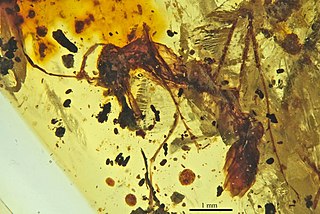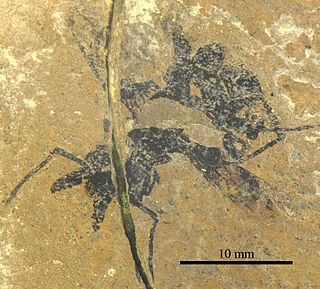
Whiteflies are Hemipterans that typically feed on the undersides of plant leaves. They comprise the family Aleyrodidae, the only family in the superfamily Aleyrodoidea. More than 1550 species have been described.

The silverleaf whitefly is one of several species of whitefly that are currently important agricultural pests. A review in 2011 concluded that the silverleaf whitefly is actually a species complex containing at least 40 morphologically indistinguishable species.

Sphecomyrma is an extinct genus of ants which existed in the Cretaceous approximately 79 to 92 million years ago. The first specimens were collected in 1966, found embedded in amber which had been exposed in the cliffs of Cliffwood, New Jersey, by Edmund Frey and his wife. In 1967, zoologists E. O. Wilson, Frank Carpenter and William L. Brown, Jr. published a paper describing and naming Sphecomyrma freyi. They described an ant with a mosaic of features—a mix of characteristics from modern ants and aculeate wasps. It possessed a metapleural gland, a feature unique to ants. Furthermore, it was wingless and had a petiole which was ant-like in form. The mandibles were short and wasp-like with only two teeth, the gaster was constricted, and the middle and hind legs had double tibial spurs. The antennae were, in form, midway between the wasps and ants, having a short first segment but a long flexible funiculus. Two additional species, S. canadensis and S. mesaki, were described in 1985 and 2005, respectively.
Baeoentedon is a genus of hymenopteran insects of the family Eulophidae, they are parasitoids of whitefly from the family Aleyrodidae which are found on trees of the genus Ficus. They have been recorded from Australia, China, India, Indonesia and Florida. A fifth species, Baeoentodon farazi, was described from Karnataka, India, in 2017.

Aleurocanthus woglumi is a species of whitefly in the family Aleyrodidae. It is a pest of citrus crops, and is commonly known as the citrus blackfly because of its slate-blue colour. It originated in Asia, but has spread to other parts of the world. The parasitic wasps, Encarsia perplexa and Amitus hesperidum can help control the pest.

Encarsia perplexa is a tiny parasitic wasp, a parasitoid of the citrus blackfly, Aleurocanthus woglumi, which is a global pest of citrus trees. It was originally misidentified as Encarsia opulenta, but was recorded as a new species in 1998. It is a native of Asia but has been introduced to many other parts of the world as a means of controlling the citrus blackfly.
Ablerus is a genus of chalcid wasps formerly belonging to the family Aphelinidae. The genus was created by the American entomologist Leland Ossian Howard in 1894 for the species named in that year by William Harris Ashmead as Centrodora clisiocampae. The genus Azotus was synonymized with Ablerus by Alexandre Arsène Girault in 1913 and Hyatt synonymized Myocnemella with Ablerus in 1994, leaving Ablerus as the sole genus within the subfamily Azotinae. Azotinae was elevated in rank in 2013 to become the monotypic family Azotidae.

Zigrasimecia is an extinct genus of ants which existed in the Cretaceous period approximately 98 million years ago. The first specimens were collected from Burmese amber in Kachin State, 100 kilometres (62 mi) west of Myitkyina town in Myanmar. In 2013, palaeoentomologists Phillip Barden and David Grimaldi published a paper describing and naming Zigrasimecia tonsora. They described a dealate female with unusual features, notably the highly specialized mandibles. Other features include large ocelli, short scapes, 12 antennomeres, small eyes, and a clypeal margin that has a row of peg-like denticles. The genus Zigrasimecia was originally incertae sedis within Formicidae until a second species, Zigrasimecia ferox, was described in 2014, leading to its placement in the subfamily Sphecomyrminae. Later, it was considered to belong to the distinct subfamily Zigrasimeciinae.

Pheidole jonas is a species of ant in the subfamily Myrmicinae.

Archimyrmex is an extinct genus of ant in the formicid subfamily Myrmeciinae, described by palaeoentomologist Theodore Cockerell in 1923. The genus contains four described species, Archimyrmex rostratus, Archimyrmex piatnitzkyi, Archimyrmex smekali and Archimyrmex wedmannae. Archimyrmex is known from a group of Middle Eocene fossils which were found in North America, South America, and Europe. The genus was initially placed in the subfamily Ponerinae, but it was later placed in Myrmeciinae; it is now believed to be the ancestor of the extant primitive genus Myrmecia from Australia. Despite this, Archimyrmex is not a member to any tribe and is regarded as incertae sedis within Myrmeciinae. However, some authors believe Archimyrmex should be assigned as incertae sedis within Formicidae. These ants can be characterised by their large mandibles and body length, ranging from 13.2 to 30 mm. They also have long, thin legs and an elongated mesosoma (thorax) and petiole.

Yantaromyrmex is an extinct genus of ants first described in 2013. Members of this genus are in the subfamily Dolichoderinae of the family Formicidae, known from Middle Eocene to Early Oligocene fossils found in Europe. The genus currently contains five described species, Y. constrictus, Y. geinitzi, Y. intermedius, Y. mayrianum and Y. samlandicus. The first specimens were collected in 1868 and studied by Austrian entomologist Gustav Mayr, who originally placed the fossils in other ant genera until the fossils were reviewed and subsequently placed into their own genus. These ants are small, measuring from 4 to 6 mm in length and can be characterized by their trapezoidal shaped head-capsules and oval compound eyes that are located slightly to the rear of the capsules midpoint, with no known ocelli present.
Paraulax queulensis is a species of gall wasp. Biology of Paraulax species is unknown but given they are associated with Nothofagus forests their biology is probably associated with the pteromalid gall community. This species is named after the place where it was first collected, Los Queules National Reserve. P. queulensis closely resembles P. perplexa, bearing common traits such as colour, habitus and several morphological characters. P. queulensis differs by having a more elongate body, which in the female is 4 times longer than it is high; its mesosoma is 1.6 times longer than high, while its metasoma is 1.9 times longer than high. The mesosoma is more dorsoventrally depressed. Its pronotum s 1.5 times longer laterally than high. It possesses longitudinal costulae running from the lateral margin of its pronotal plate to its lateral surface. Its scutellar foveae is discernible even when shallow. The antenna also differs: the pedicel of the female antenna is 1.4 times longer than wide.
Paraulax ronquisti is a species of gall wasp. Biology of the Paraulax species is unknown but given they are associated with Nothofagus forests their biology is probably associated with the pteromalid gall community. It is named in honour of Fredrik Ronquist. This species differs from P. perplexa and P. queulensis by its body's red-brown color, the shape of the antennal flagellomeres F3 and F4, the faint notauli and its smooth and shiny mesopleuron. It has an elongated body like P. queulensis.

Myanmyrma is an extinct genus of ants not placed into any Formicidae subfamily. Fossils of the single known species, Myanmyrma gracilis, are known from the Middle Cretaceous of Asia. The genus is one of several ants described from Middle Cretaceous ambers of Myanmar.

Protopone is an extinct genus of ants in the formicid subfamily Ponerinae described from fossils found in Europe and Asia. There are seven described species placed into the genus, Protopone? dubia, Protopone germanica, Protopone magna, Protopone oculata, Protopone primigena, Protopone sepulta, and Protopone vetula. Protopone is one several Lutetian Ponerinae genera.

Cephalopone is an extinct genus of ants in the formicid subfamily Ponerinae described from fossils found in Europe. There are two described species placed into the genus, Cephalopone grandis and Cephalopone potens. Cephalopone is one several Lutetian Ponerinae genera.

Cyrtopone is an extinct genus of ants in the formicid subfamily Ponerinae described from fossils found in Europe. There are four described species placed into the genus, Cyrtopone curiosa, Cyrtopone elongata, Cyrtopone microcephala, and Cyrtopone striata. Cyrtopone is one several Lutetian Ponerinae genera.

Messelepone is an extinct genus of ants in the formicid subfamily Ponerinae described from fossils found in Europe. M. leptogenoides is the only species assigned to the genus, which is one of several Lutetian Ponerinae genera.
Baeoentedon balios, the balios wasp, is a species of chalcid wasp which was first described from China in 2014. It is a parasitoid of whiteflies of the family Aleyrodidae.

Aleurocanthus spiniferus, the citrus spiny whitefly, is an important pest of citrus and tea plants. They are part of the order Hemiptera, and the family Aleyrodidae, where more than 1550 species have been described. A. spiniferus is indigenous to parts of tropical Asia, where it was first discovered in Japan. Since its discovery, it has now spread to numerous continents including Africa, Australia, America, Pacific Islands and Italy. Wherever it is found, it has become a highly destructive pest. Two populations of A. spiniferus have been found according to the plant or crop they infest: the citrus spiny whitefly, as well as the tea spiny whitefly.














